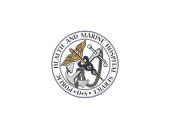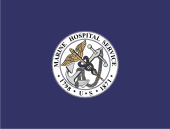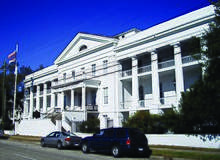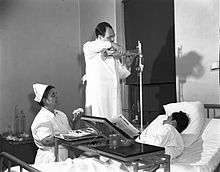Marine Hospital Service


The Marine Hospital Service was an organization of Marine Hospitals dedicated to the care of ill and disabled seamen in the U.S. Merchant Marine, the U.S. Coast Guard and other federal beneficiaries. The Marine Hospital Service evolved into the U.S. Public Health Service Commissioned Corps.
History
.jpg)
The Service was created by an act of the 5th United States Congress, which was signed into law on 16 July 1798 by President John Adams. The name of the act is "An Act for the relief of sick and disabled Seamen" and it was the first federal health law.[1] "An Act for the relief of sick and disabled Seamen" authorized a tax, which was the deduction of twenty cents per month from the wages of the seamen.[2] This tax raised funds for physicians and to support the network of hospitals.[3] In 1884, the tax was abolished and in 1906 funds were dispensed by Congress. The act led to the gradual creation of a network of hospitals along coastal and inland waterways.[4] Listed below is the timeline of events taken from the U.S. Department of Health and Human Services.
Timeline
1798
The Congressional Act of 1798 was signed into law by President John Adams. It created a tax of 20 cents each month to be withheld from seamen’s wages for support of marine hospitals. The money was paid to the U.S. Collector of Customs. This was the first example of pre-paid health insurance in U.S. history.[5] The Act was expanded in 1799 to include all "officers, seamen and marines of the navy of the United States"[6]
1801
In 1801, the first marine hospital owned by the Federal government was located at Washington Point in Virginia. Other early marine hospitals were established in the port cities of Boston, Massachusetts; Newport, Rhode Island; New Orleans, Louisiana; Mobile, Alabama; and Charleston, South Carolina.[7]

1803
The first permanent Marine hospital was authorized to be built in Boston, Massachusetts.[8]
1836
Kentucky Senator Henry Clay sponsored legislation for the U.S. Marine Hospital to be built in Louisville, "for the of sick seamen, boatmen, and other navigators on the western rivers and lakes."[9]
1870
This practice continued until 1870, excepting one year from April 1837 to 1838. A bill was enacted to centralize and reorganize the Marine Hospital Service, with its headquarters in Washington, DC, under the position of supervising surgeon. [10]This act also raised the hospital tax from 20 cents to 40 cents until 1884.[11][12]
1871
John Maynard Woodworth, the first supervising surgeon, adopted a military model for his medical staff as part of system reform. Woodworth instituted examinations for applicants and implemented required uniforms for physicians, He created a cadre of mobile, career-service physicians assigned to various marine hospitals. [13]
1878
The prevalence of major epidemic diseases such as smallpox and yellow fever across the globe spurred Congress to enact the National Quarantine Act to prevent the introduction and spread of contagious and infectious disease in the United States. The task of controlling epidemic diseases through quarantine and disinfection measures, as well as immunization programs, within the country fell to the Marine Hospital Service, such as these Public Health Service officers in uniform as the Montauk Point, New York Quarantine Station. [14]
1879
The National Board of Health was created by the 15th U.S. Congress through an act that was titled, "An Act to prevent the Introduction of Infectious or Contagious Disease in the United States and to Establish a National Board of Health." The board had 11 members 7 of which were appointed by the president, 3 were medical officers from the Navy, Marine Hospital Service and the Army, and the last member was a representative from the office of the Attorney General. The National Board of Health was responsible for conserving and improve public health. This was the first Federally organized effort for comprehensive medical research. They were also given the power to quarantine.[15]
1887
A one-room bacteriological laboratory was created within the Marine Hospital Service in Staten Island, New York by Dr. Joseph Kinyoun. It was known as the Laboratory of Hygiene. It was established to conduct research on cholera and several other infectious diseases. It was later redesignated as the National Institute of Health in 1930.
1889
An Act of Congress established the United States Public Health Service Commissioned Corps and formalized the Commissioned Corps as the uniformed services component of the Marine Hospital Service. Congress organized Corps officers along military lines with titles and pay corresponding to Army and Navy grades. [16]
1890
The Marine Hospital Service was given interstate quarantine powers by Congress.[17] This was done as an effort to control the spread of epidemic diseases.[18]
1902
The Marine Hospital Service expanded to the Public Health and Marine Hospital Service to reflect growing responsibilities. Officers continued to carry out quarantine duties, which now included the medical inspection of arriving immigrants, such as those landing at Ellis Island in New York. Public Health and Marine Hospital Service officers played a major role in fulfilling the commitment to prevent disease from entering the country. [19]
1912
The name of the Public Health and Marine Hospital Service was shortened to the Public Health Service (PHS). Legislation enacted by Congress broadened the powers of the PHS by authorizing investigations into human disease (such as tuberculosis, hookworm, malaria, and leprosy), sanitation, water supplies, and sewage disposal. [20]
1936
Surgeon General Thomas Parran led the fight against venereal disease and paved the way for modern public health organizations. He strengthened and extended the research programs at the National Institutes of Health, established the Communicable Disease Center (later Centers for Disease Control and Prevention), and participated in the planning of the World Health Organization. [21]
1944
The PHS Act of 1944 broadened the scope of the Commissioned Corps, allowing for the commissioning of nurses, scientists, dietitians, physical therapists, and sanitarians (later health service officers). From 1940 to 1945, the Commissioned Corps quadrupled its numbers from 625 officers to 2,600. [22]
1964
Surgeon General Dr. Luther Terry released a landmark report that concluded that lung cancer and chronic bronchitis are causally related to cigarette smoking. The report was the first such analysis that laid out the effects of tobacco and smoking and it spurred initiatives to lower tobacco use among Americans. [23]
1986
Dr. C. Everett Koop served as Surgeon General as the nation began to recognize AIDS as a new and deadly disease. Koop became the chief Federal spokesperson on AIDS and released a report on AIDS that contributed significantly to providing information on the disease. Koop also wrote "Understanding AIDS," the PHS brochure based on CDC guidelines that was sent to all 107 million households in the United States in 1988, the largest public health mailing ever at the time.[24]
2005
More than 2,400 Commissioned Corps officers were deployed to the Gulf Region before, during, and after Hurricanes Katrina, Rita and Wilma. This is the largest deployment in numbers in Commissioned Corps history. The officers set up and staffed field hospitals and emergency medical clinics. treated sick and injured evacuees, conducted disease surveillance, and worked closely with local and State health authorities to plan for long-term public health needs.[25]
2008
The Department of Defense and the Department of health and Human Services (HHS) established the "DoD-USPHS Partnership for Psychological Health" initiative. Officers in the Commissioned Corps were detailed to military medical treatment facilities across the nation to ensure that service members and their families received the resources they needed by increasing the availability of behavioral health service providers.[26]
Today, the Commissioned Corps continues to fulfill its mission to protect, promote, and advance the health and safety of the nation under the leadership of the Assistant Secretary of Health and the U.S. Surgeon General. The Corps contributes to ground-breaking health initiatives, included the 2014 Surgeon General's Report that highlighted 50 years of progress in tobacco control and prevention, presented new data on the health consequences of tobacco use, and detailed initiatives that can end the tobacco epidemic in the United States. The Commissioned Corps' response to national health threats and other recent disasters underscores the value to our nation of having a highly trained, multidisciplinary, and quickly mobilized cadre of officers.[27] The Marine Hospital Fund was a unique and early mechanism to provide the first publicly funded health care and disease prevention federal agency in the United States.[28]
Funding
Following the Civil War, public outcry and scandal surrounded the Marine Hospital Fund. In 1869, Dr. John Shaw Billings, a prominent Army surgeon, was appointed to head an investigation of the Marine Hospital Fund. Dr. Billings found the hospital fund to be inadequate and completely unorganized. In June 1870 the 41st Congress formally reorganized the Marine Hospital Fund as the Marine Hospital Service. Dr. John Maynard Woodworth was subsequently appointed to the Service as "Supervising Surgeon." He transformed the service into a disciplined organization based on his experience in the Union Army as a surgeon. Dr. Woodworth required his physicians to be a mobile work force stationed where the service was in need, and he mandated the daily wear uniforms. This eventually led to the creation of the modern-day Public Health Service Commissioned Corps. Dr. Woodworth, using Army-style heraldry, created the Marine Hospital Service fouled anchor and caduceus seal which is used to this day by the Public Health Service. In 1873, Dr. Woodworth’s title was changed to "Supervising Surgeon General," a forerunner of the modern-day office of Surgeon General of the United States.[29]


It was the point of origin for the Public Health Service and the Public Health Service Commissioned Corps of the present-day Department of Health and Human Services, and current Operating Divisions (OPDIV) and Staffing Divisions that include the National Institutes of Health, the Centers for Disease Control and Prevention, Indian Health Service, and a host of other federal-level health programs. The Marine Hospitals, as their name suggests, were hospitals constructed at key sea and river ports across the nation to provide health care for merchant marine sailors. Aside from the well-being of these sailors, the hospitals provided a key monitoring and gate-keeping function against pathogenic diseases.[30]
As the nation grew, the scope of Marine Hospital Service's scope of duties grew to include domestic and foreign quarantine and other national public health functions. In 1902, the Marine Hospital Service was renamed the "Public Health and Marine-Hospital Service." In 1912, the name of the service was changed to the Public Health Service to encompass its diverse and changing mission. Over time, the hospitals of the service were also expanded to include research and prevention work as well as the care of patients. Aside from merchant seamen, members of the military, immigrants, Native Americans, other federal beneficiaries, and people affected by chronic and epidemic diseases found a source for health care in the PHS and its hospitals.
The hospitals themselves were, by the middle of the 19th century, fairly imposing and architecturally grand structures in many cases. As long as ample federal funding was available for their construction, these hospitals were impressive examples of government-provided health care. The hospitals of the early 20th century in major port cities such as New Orleans, San Francisco, and Savannah displayed ornate architectural detail and reflected many of the changes sweeping medicine at the time.
During the Nixon administration, funding was cut to the PHS hospitals program and many of these institutions closed or were turned over to local public health offices. Eight survived as federal institutions until the early 1980s, when further budget cuts put an end to their funding. Some, such as the one in Savannah, Georgia, continued as outpatient low-income health clinics up to 2003 while others, such as the large hospital in San Francisco on the grounds of the US Army Presidio, were diverted to other Federal and military uses. In the case of the Presidio, the PHS Hospital was used as a site for language training for military officers in the late 1980s.
Today, the records for these institutions sit in storage at the National Library of Medicine in Bethesda, Maryland and the National Archives in College Park, Maryland.
See also
References
- ↑ "Public Health". marinehospital.org. Retrieved 2018-03-07.
- ↑ "Justice Network - Sick and Disabled Seaman Act of 1798 Govt. Healthcare". www.nosue.org. Retrieved 2018-03-07.
- ↑ "Public Health in the United States". sphweb.bumc.bu.edu. Retrieved 2018-03-07.
- ↑ "https://www.usphs.gov/aboutus/history.aspx". www.usphs.gov. Retrieved 2018-03-07. External link in
|title=(help) - ↑ "Office of History, National Institutes of Health - Legislative Chronology". history.nih.gov. Retrieved 2017-12-03.
- ↑ "Office of History, National Institutes of Health - Legislative Chronology". history.nih.gov. Retrieved 2017-10-18.
- ↑ "https://www.usphs.gov/aboutus/history.aspx". www.usphs.gov. Retrieved 2017-11-17. External link in
|title=(help) - ↑ "Chronology of Events". National Institutes of Health (NIH). 2015-02-11. Retrieved 2017-12-03.
- ↑ "Marine Hospital Historic Timeline" (PDF).
- ↑ "https://www.usphs.gov/aboutus/history.aspx". www.usphs.gov. Retrieved 2017-11-17. External link in
|title=(help) - ↑ "Office of History, National Institute of Health-Research" (PDF).
- ↑ "Office of History, National Institutes of Health - Legislative Chronology". history.nih.gov. Retrieved 2017-12-03.
- ↑ "https://www.usphs.gov/aboutus/history.aspx". www.usphs.gov. Retrieved 2017-11-17. External link in
|title=(help) - ↑ "https://www.usphs.gov/aboutus/history.aspx". www.usphs.gov. Retrieved 2017-11-17. External link in
|title=(help) - ↑ "Office of History, National Institutes of Health - Legislative Chronology". history.nih.gov. Retrieved 2017-12-03.
- ↑ "https://www.usphs.gov/aboutus/history.aspx". www.usphs.gov. Retrieved 2017-11-17. External link in
|title=(help) - ↑ "Office of History, National Institutes of Health - Legislative Chronology". history.nih.gov. Retrieved 2017-12-03.
- ↑ "Images From the History of the Public Health Service: Disease Control and Prevention, Fighting the Spread of Epidemic Diseases". www.nlm.nih.gov. Retrieved 2017-12-03.
- ↑ "https://www.usphs.gov/aboutus/history.aspx". www.usphs.gov. Retrieved 2017-11-17. External link in
|title=(help) - ↑ "https://www.usphs.gov/aboutus/history.aspx". www.usphs.gov. Retrieved 2017-11-17. External link in
|title=(help) - ↑ "https://www.usphs.gov/aboutus/history.aspx". www.usphs.gov. Retrieved 2017-11-17. External link in
|title=(help) - ↑ "https://www.usphs.gov/aboutus/history.aspx". www.usphs.gov. Retrieved 2017-11-17. External link in
|title=(help) - ↑ "https://www.usphs.gov/aboutus/history.aspx". www.usphs.gov. Retrieved 2017-11-17. External link in
|title=(help) - ↑ "https://www.usphs.gov/aboutus/history.aspx". www.usphs.gov. Retrieved 2017-11-17. External link in
|title=(help) - ↑ "https://www.usphs.gov/aboutus/history.aspx". www.usphs.gov. Retrieved 2017-11-17. External link in
|title=(help) - ↑ "https://www.usphs.gov/aboutus/history.aspx". www.usphs.gov. Retrieved 2017-11-17. External link in
|title=(help) - ↑ "https://www.usphs.gov/aboutus/history.aspx". www.usphs.gov. Retrieved 2017-11-17. External link in
|title=(help) - ↑ Bell, Shannon. "Old Marine Hospital". www.nps.gov. Retrieved 2017-12-03.
- ↑ ASPA. "John Maynard Woodworth (1871-1879)". www.surgeongeneral.gov. Retrieved 2017-12-03.
- ↑ "Images From the History of the Public Health Service: Introduction". www.nlm.nih.gov. Retrieved 2017-12-03.
External links
| Wikimedia Commons has media related to United States Marine Hospitals. |
- The National Library of Medicine has a guide to the documents culled from various PHS hospitals when these closed.
- marinehospital.org- Website of the U.S. Hospital Foundation, which is restoring the Marine Hospital in Louisville, Kentucky.